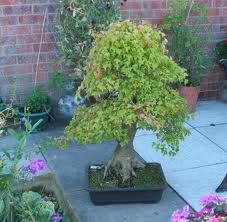 Overview
Overview
Bonsai is the art of keeping a miniature tree in a small pot that mimics the look and feel of a much older, larger tree in nature. Although most bonsai pots are flat and wide, some can be tall and thin, especially for trees grown in a cascading style. In some cases, bonsai trees can be grown on the surface of porous, volcanic rock which is subsequently placed on a flat pan to catch water runoff.
History
Bonsai originated during the Han Dynasty (206 B.C. to 220 A.D.) in China where it is called pen tsai. Miniature trees were created as parts of miniature landscapes ordered by one of the Han emperors. Because these early miniature trees were for the emperor’s pleasure only, possession of the trees by anyone other than the emperor was punishable by death. After the Han Dynasty, the trees began to gain popularity outside of the court. By the Heinan period (794 to 1191) in Japan, bonsai was brought to Japan with Buddhist practices and began to gain popularity. Over time, it spread to include many classes in Japan.
Styles
There are many styles of bonsai tree. Some trees are better suited to certain styles, and some styles will simply not work with a particular type of tree. Although there are a number of traditional styles, there are even more modern styles. In bonsai shows, often the tree that strays from a pure classic style will be the one that receives accolades. Common classical styles include formal upright, informal upright, literati, windswept, cascade, root over rock, root on rock, driftwood, group and broom.
Locations
Although many people associate bonsai with indoor cultivation, indoor bonsai growing is a modern invention. Historically, bonsai was made using native species that stayed outside. Many people, especially in China and Japan, still grow bonsai this way. Trees spend most of their time outdoors in naturally ideal growing conditions and are only brought in for a few days when they are at their peak. By growing many trees, they are rotated into a display location or alcove.
Trees
Almost any tree can be trained as a bonsai. The style of bonsai is often defined by the type of tree. For example, junipers often have a natural tendency to grow long, windswept forms that are ideal for windswept style. With long-term growth and care, a juniper can also work well as a literati style or even a cascading style. Flowering trees often work very well as cascading style trees. Trees like elms often do better as formal or informal uprights.
Styling
Basic bonsai styling involves severe pruning of both the upper portions of the tree and the roots. Bonsai requires the removal of one-third to two-thirds of the roots every two years or so. Root pruning helps to maintain the miniature stature of the trees. The styling and movement of branches and trunks using wire is a mid-level styling technique. Advanced techniques include partially stripping the bark to create a driftwood effect and creating broken branch effects called jin effects.

Deprecated: strpos(): Passing null to parameter #1 ($haystack) of type string is deprecated in /home/agriviek8Qv/agriviet.net/public_html/wp-includes/comment-template.php on line 2522